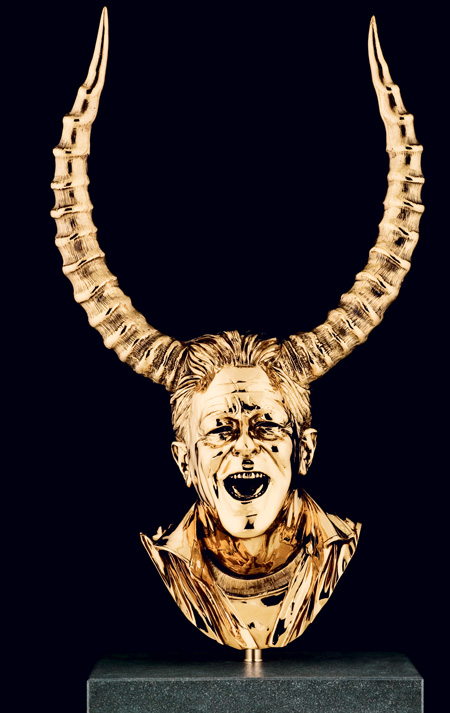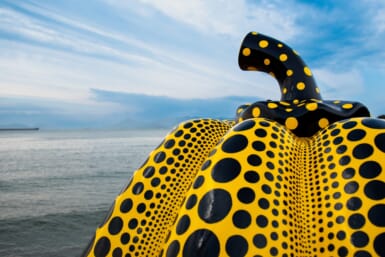by Owen Schaefer
First you pass through a hallway in the Museum of Contemporary Art Tokyo lined with dozens of humorous and grotesque busts of artist Jan Fabre: Antlers grow from his head, he sprouts ears like a rabbit or a narwhal’s tooth. Once through this hallway of chimeras, you are led downstairs into a sculpture garden in the venue’s indoor courtyard where you meet with the blank stare of a woman (by Bharti Kher) who has a monkey’s head and one horse’s leg, and cyborg-like female torsos (by Lee Bul) that replace flesh with machine. Clearly, these are not the classical transformations of Actaeon or Narcissus.
But then again, the 21-artist show is intended to be less about magic and more about the real changes that society is coming closer to facing, the genetic, technological and social transformations that could challenge our sense of what it means to be human. Unfortunately, despite the wide scope and clever original concept of “Transformations”, the bulk of the show comes off a little jumbled and, sadly, dull.
The biggest problem is simply the huge number of works on video and film. I consider myself a patient viewer and will watch a long film installation without complaint; but moving from one video work to the next, room after room, many of them clocking in at more than half an hour, is tiring for both the senses and the legs. I was in the museum for somewhere in the neighborhood of four hours and didn’t even come close to watching everything.
Also, there is a star-struck quality to the show as certain works seem to have been brought in mainly for the artist’s name. I am a fan of Apichatpong Weerasethakul’s films, and yet the work here, “The Man Who Ate an Entire Tree”, is a kind of semi-documentary look at workers struggling to save a forested area from an invading species of vine. Its connection to the theme is tenuous at best, and the film not his greatest.
Then there is Matthew Barney, whose “Cremaster” series of films is a guaranteed draw for crowds. For “Transformations,” Barney is given an entire room devoted to a series of related photographs, a sculpture/installation and two monitors showing “Cremaster 3”.
But while there are levels of transformation involved in Barney’s basic idea for the film series, the entire thing is a morass of heavy-handed metaphor plodding along in lengthy scenes that have only the veneer of polished cinematography.
Still, there are short and sweet offerings that are worth the time. I was excited to see that Patricia Piccinini would be involved in the show. Piccinini is known for her disturbingly life-like sculptures of human-animal hybrids and genetically modified humans, so her work should be a perfect fit for “Transformations”. It was disappointing to find only a single small sculpture to represent her wealth of her physical works dealing with questions of genetics, but then, an unexpected pleasure was Piccinini’s film — a short piece in which a woman is swimming alone in the ocean. At first, she seems lost, perhaps even drowning, but in time we see why this isn’t the case, and it’s worth every frame.
Other strong pieces include the almost painful-to-watch film “Quimera” by Brazilian artist Tunga, in which a man shaves his “beard” — a live cat curled around his chin — while a host of stray cats dart through the streets outside. Masakatsu Takagi’s “Ymene” purports to allow us to see the world as a bird might; while the concept alone is interesting, the effects are mind-blowing. And Simon Birch, in an almost-hidden installation on the bottom floor, reverses the animal-captor relationship with “Tehlirian”.
There are great works in Transformation — it just seems a shame that the butterfly which it could have been, never really spreads its wings.
Exhibition: ”Transformation”
(till Jan. 30)
Venue: Museum of Contemporary Art Tokyo
(Kiba Station)
Hours: 10 am–6 pm (closed Mon.)
Admission: ¥1,300
More info: Visit www.mot-art-museum.jp
or call (03) 5405-8686









